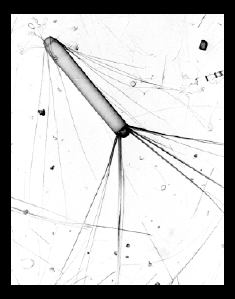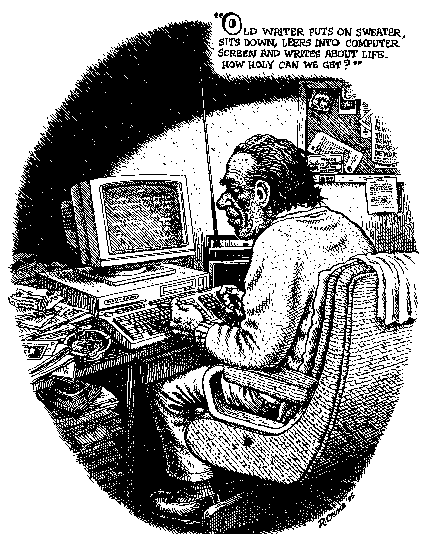Tipping
Point
How Little Things Can
Make a Big Difference
Malcolm Gladwell
(Little, Brown)
Malcolm Gladwell claims that there are certain moments when a tiny push can make big things happen, but his view is slightly smaller than revolutions and World Wars. He talks of Hush Puppies, for example, those funky shoes from long ago that suddenly came back into fashion. He speaks of yawning, drug addiction and AIDS in Baltimore, juvenile suicide in Indonesia and kids smoking cigarettes in the US. The number 150 (as the optimal number of a business or association), the "broken window" theory --- tied to the rise and fall of crime in New York City --- the coming of "Sesame Street" and, later, "Blues Clues." There are the rules of epidemics, and there is the law of the few. These are all grist for his mill.
The author is an excellent writer, piques our interest --- but the truly gripping parts of The Tipping Point are the myriad of details that flesh out his theory. For example, there's Peter Jenning's ill-disguised prejudice. Soundless videos, when viewed by a study group, proved that Jenning's face was "glowing" when he was reporting on the details of Reagan's presidential candidacy. It is thought that this may have influenced the election. Or, even better, there's the matter of Paul Revere.
The author compares Revere to William Dawes. Both left about the same time on the same evening to spread the news about the British. The response to Dawes: practically nil. Why was Revere so instrumental in rousing the natives? Because he was what Gladwell calls a "connector." He was a person that people liked, trusted and respected. His thirteen mile ride was not only knocking on doors and spreading the word, but because he was "a doer, a man blessed...with 'an uncanny genius for being at the center of events,'" his appearance galvanized people to action. Even before his famous ride, he regularly traveled between Philadelphia, New York, and Boston. He was a Mason, he was health officer of Boston, and coroner of Suffolk County:
He was so naturally and irrepressibly social...When he came upon a town, he would have known exactly whose door to knock on, who the local militia leader was, who the key players in town were. He had met most of them before. And they knew and respected him as well.
He was, in other words, a person not unlike ones you and I know --- one who is fun to be with, smart, always filled with ideas, telling us which restaurants to go to, where bargains are, who is doing something interesting. He is the "connector."
 Outside of Gladwell's theory of "connectors, mavens, and salesmen," The Tipping Point is chock-a-block filled with details of studies that have been done on unbelievable subjects in unbelievable places. Baltimore has a needle exchange program. It was found early on that when the needle truck arrived in the seedy parts of town, there were always four or five people who turned up with hundreds of dirty needles. These they traded for the clean ones, which they turn around and sold to the junkies for a dollar a piece. They were connectors, and rather than trying to thwart them, the organizers of the program found them extremely helpful:
Outside of Gladwell's theory of "connectors, mavens, and salesmen," The Tipping Point is chock-a-block filled with details of studies that have been done on unbelievable subjects in unbelievable places. Baltimore has a needle exchange program. It was found early on that when the needle truck arrived in the seedy parts of town, there were always four or five people who turned up with hundreds of dirty needles. These they traded for the clean ones, which they turn around and sold to the junkies for a dollar a piece. They were connectors, and rather than trying to thwart them, the organizers of the program found them extremely helpful:
They are all very well connected people [said epidemiologist Tom Junge]. They know Baltimore inside and out. They know where to go to get any kind of drug and any kind of needle. They have street savvy. I would say that they are unusually socially connected. They have a lot of contacts....I would have to say the underlying motive is financial or economic. But there is definitely an interest in helping people out.
Then there is the controversial "broken windows" theory: if you don't fix the little things in a city (broken windows, garbage, panhandlers, scofflaws) then crime becomes more prevalent. The reason?
The criminal --- far from being somene who acts for fundamental intrinsic reasons and who lives in his own world --- is actually someone acutely sensitive to his environment, who is alert to all kinds of cues, and who is prompted to commit crimes based on his perception of the world around him.
If the environment is dirty and messy, it leads those on the edge to believe that they can get away with murder. Gladwell calls it "The Power of Context."
finally, in his peripheral vision, he saw what he had always sensed was there: "the wife turning her head exactly as the husband's hands came up." From there he picked up other micromovements, other patterns that occurred over and over again, until he realized that in addition to talking and listening, the three people around the table were also engaging in what he termed "interactional synchrony." Their conversation had a rhythmic physical dimention. Each person would, within the space of one or two or three 1/4th-of-a-second frames, move a shoulder or cheek or an eyebrow or a hand, sustain that movement, stop it, change direction, and start again....the speaker was, in effect, dancing to his or her own speech. At the same time the other people around the table were dancing along as well, moving their faces and shoulders and hands and bodies to the same rhythm. It's not that everyone was moving the same way, any more than people dancing to a song all dance the same way. It's that the timing of stops and starts of each person's micromovements --- the jumps and shifts of body and face --- were perfectly in harmony. Thus, as we converse, you and I dear, we are dancing to each other's words --- only the dance is so subtle, the movements so tiny, that we can only catch it subconsciously. (What Gladwell left out is Condon's description of speaking: as we speak, whoever we are talking to is also moving lips and mouth so that we are speaking in tandem. Only the movements are so tiny that they can only be seen if one slows down the action, gets a frame- It's all a part of Gladwell's theory of "tipping points" --- all of which he describes so richly and so well --- along with a rich admixture of other studies: how supersalesmen work, stories of how movers-&-doers make things happen, how babies (too) move to the speech patterns of adults, how they experiment with different episodes of "Sesame Street" to see which the kids preferred, how two people who live together begin to create a collective memory (one remembers the days to pay bills; the other remembers when it is time to clean the refrigerator); how the kids prefer to commit suicide in Indonesia (leaning over with a rope around the neck); how some people can smoke cigarettes and not become addicted; who in the agriculture business will try out a new seed (they're called Ealy Adopters); how one company, Gore Associates, immediately splits its workforce when it reaches 150 --- for after that point, the communication between employees begins to break down; and even, my god how he sticks in facts from all over --- how Methodism got started. The author cites, at length, and explains, wonderfully clearly, one of my favorite studies. That is --- what happens when people talk. A couple of decades ago, William Condon studied a 4-1/2 second film, in which a woman says to a man and child, You all should come around every night. We never have had a dinnertime like this in months. Condon worked on this short segment for a year and a half, frame-
The author cites, at length, and explains, wonderfully clearly, one of my favorite studies. That is --- what happens when people talk. A couple of decades ago, William Condon studied a 4-1/2 second film, in which a woman says to a man and child, You all should come around every night. We never have had a dinnertime like this in months. Condon worked on this short segment for a year and a half, frame-
 It's been years since we've sampled Bukowski, and we wanted to see if he had aged, as we have --- for better or for worse. After three pages of Ham on Rye, we were hooked --- and after three days, we knew why he, along Henry Miller, R. Crumb, Allen Ginsburg, Jack Kerouac, and J. D. Salinger were the word mauvens of our salad days.
It's been years since we've sampled Bukowski, and we wanted to see if he had aged, as we have --- for better or for worse. After three pages of Ham on Rye, we were hooked --- and after three days, we knew why he, along Henry Miller, R. Crumb, Allen Ginsburg, Jack Kerouac, and J. D. Salinger were the word mauvens of our salad days.